Business Finance Homework: Financial Analysis and Valuation
VerifiedAdded on 2020/02/19
|8
|1240
|48
Homework Assignment
AI Summary
This document presents a comprehensive solution to a business finance assignment, addressing key concepts such as asset maximization, nominal and compounding interest rates, and investment valuation. The assignment delves into calculations of present and future values, analyzing the profitability of investments and the impact of interest rates on financial decisions. It includes detailed calculations for loan installments, future value of ETF funds, and present value of retirement allowances. Furthermore, the solution explores the present value of cash flows from insurance coverage, offering a complete understanding of financial planning and investment strategies. The assignment covers various aspects of finance, providing a well-rounded analysis of financial concepts and their practical applications.
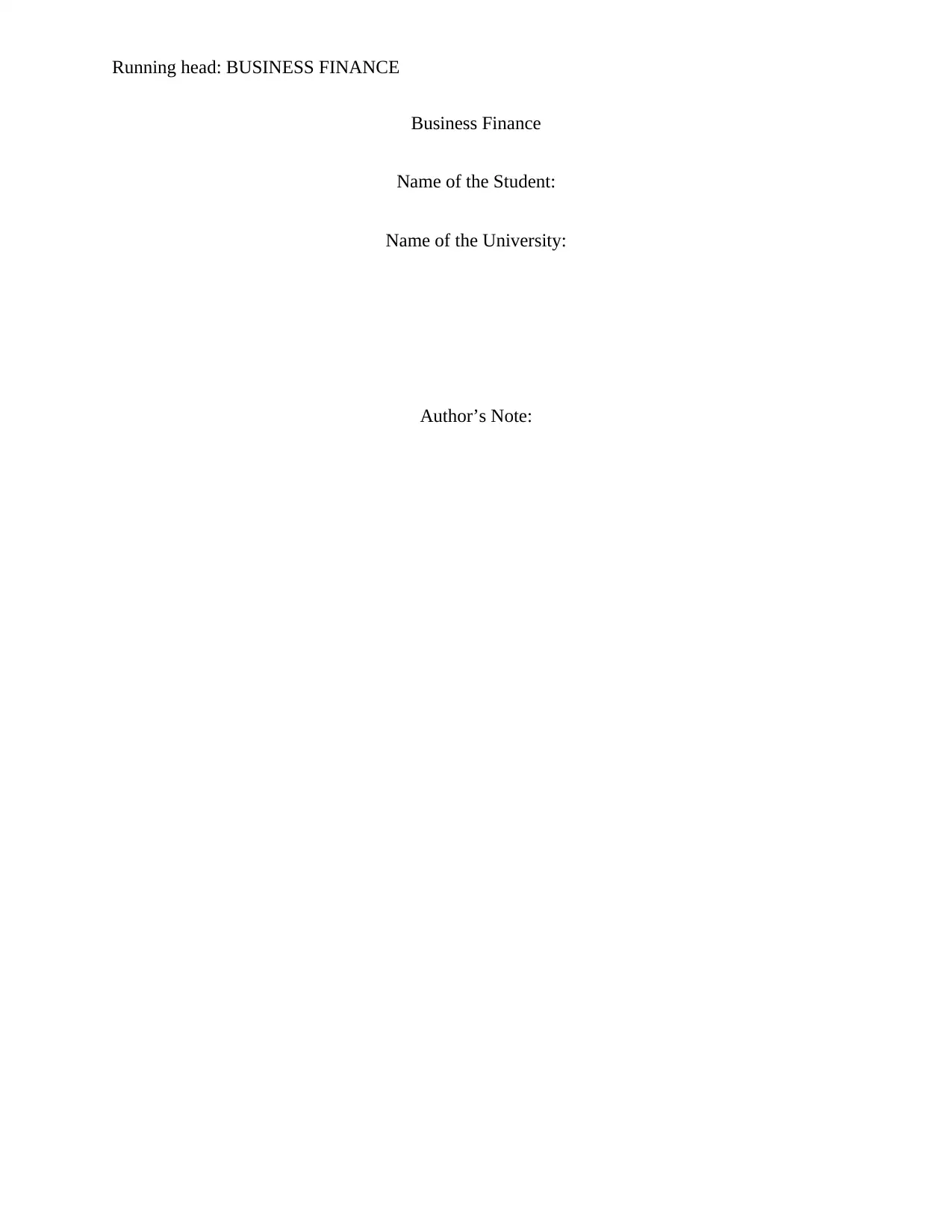
Running head: BUSINESS FINANCE
Business Finance
Name of the Student:
Name of the University:
Author’s Note:
Business Finance
Name of the Student:
Name of the University:
Author’s Note:
Paraphrase This Document
Need a fresh take? Get an instant paraphrase of this document with our AI Paraphraser
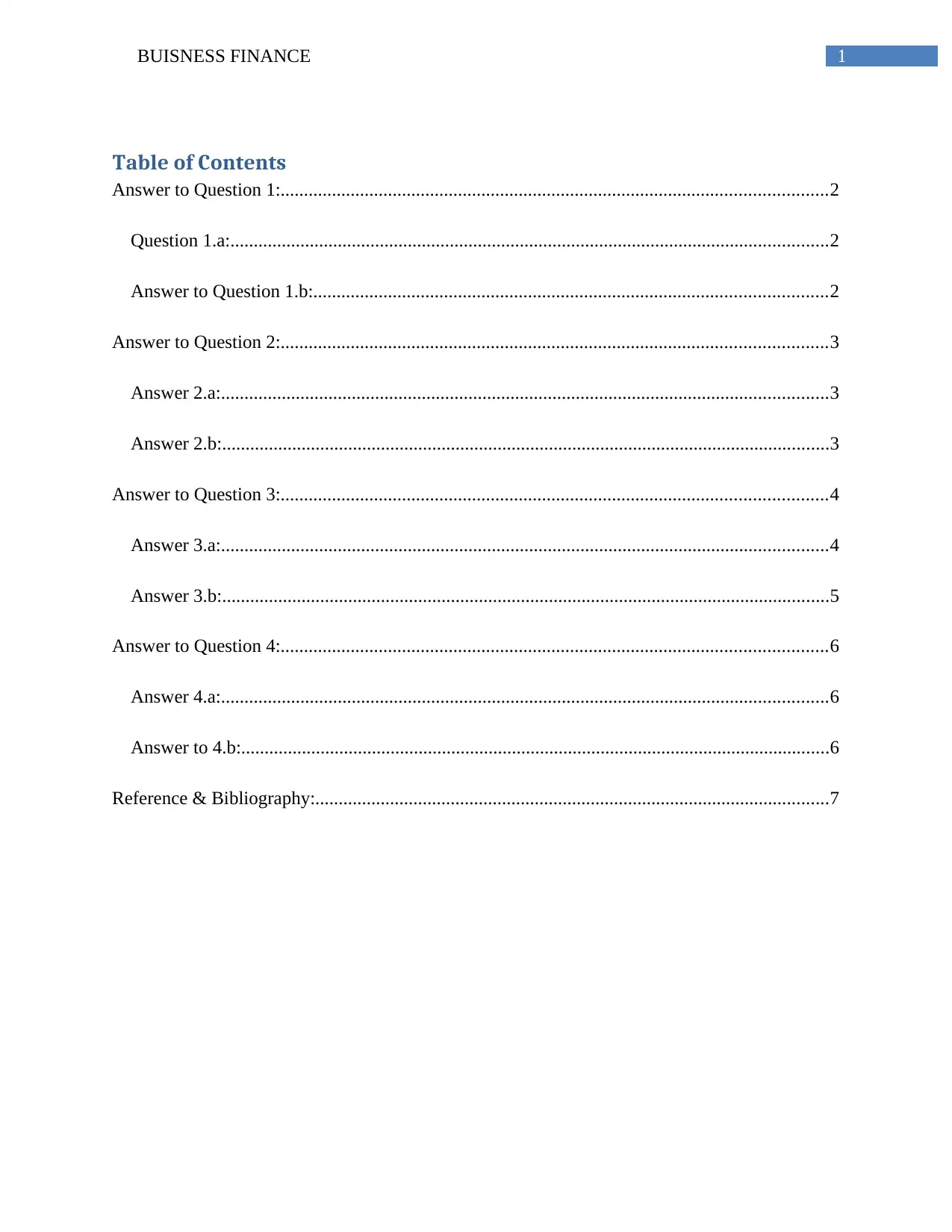
1BUISNESS FINANCE
Table of Contents
Answer to Question 1:.....................................................................................................................2
Question 1.a:................................................................................................................................2
Answer to Question 1.b:..............................................................................................................2
Answer to Question 2:.....................................................................................................................3
Answer 2.a:..................................................................................................................................3
Answer 2.b:..................................................................................................................................3
Answer to Question 3:.....................................................................................................................4
Answer 3.a:..................................................................................................................................4
Answer 3.b:..................................................................................................................................5
Answer to Question 4:.....................................................................................................................6
Answer 4.a:..................................................................................................................................6
Answer to 4.b:..............................................................................................................................6
Reference & Bibliography:..............................................................................................................7
Table of Contents
Answer to Question 1:.....................................................................................................................2
Question 1.a:................................................................................................................................2
Answer to Question 1.b:..............................................................................................................2
Answer to Question 2:.....................................................................................................................3
Answer 2.a:..................................................................................................................................3
Answer 2.b:..................................................................................................................................3
Answer to Question 3:.....................................................................................................................4
Answer 3.a:..................................................................................................................................4
Answer 3.b:..................................................................................................................................5
Answer to Question 4:.....................................................................................................................6
Answer 4.a:..................................................................................................................................6
Answer to 4.b:..............................................................................................................................6
Reference & Bibliography:..............................................................................................................7
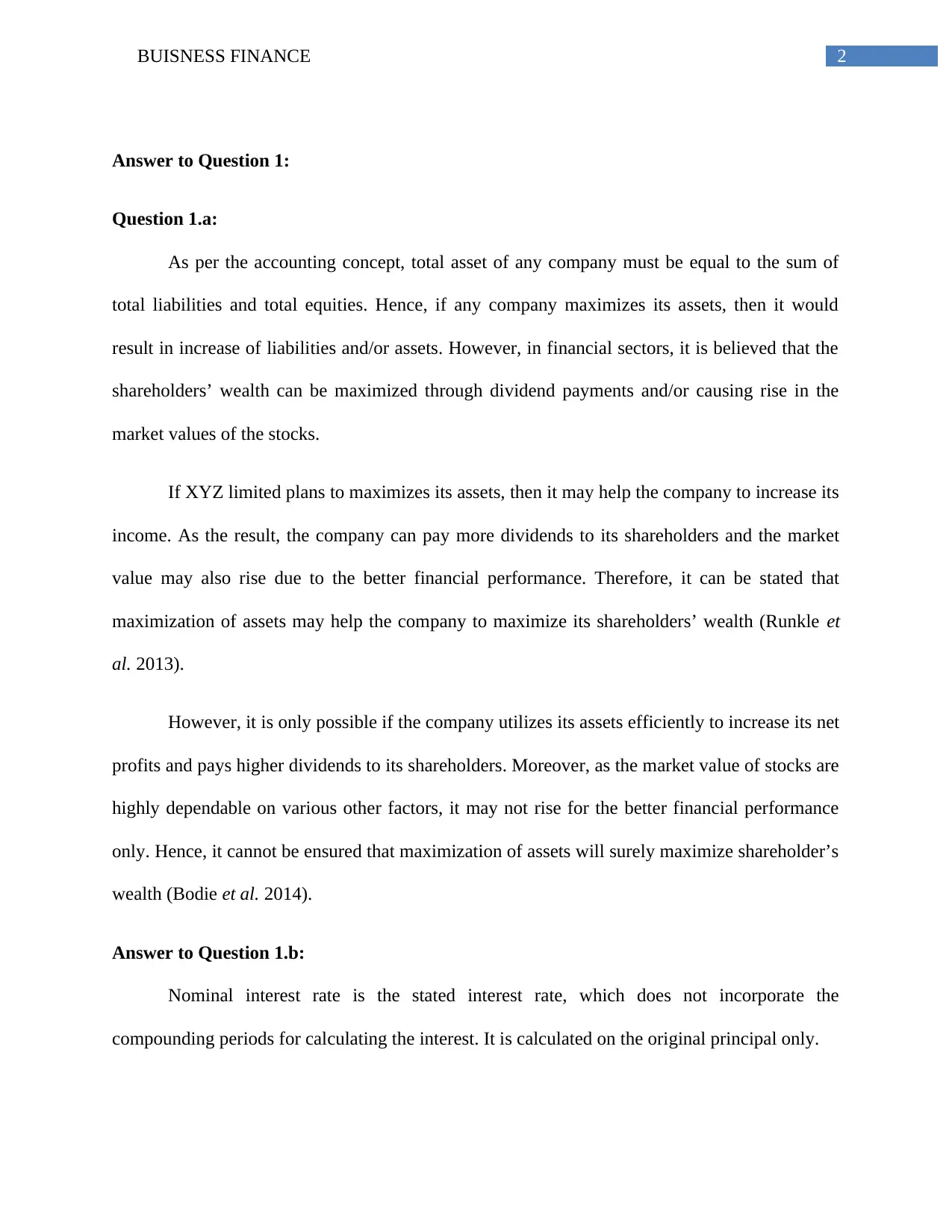
2BUISNESS FINANCE
Answer to Question 1:
Question 1.a:
As per the accounting concept, total asset of any company must be equal to the sum of
total liabilities and total equities. Hence, if any company maximizes its assets, then it would
result in increase of liabilities and/or assets. However, in financial sectors, it is believed that the
shareholders’ wealth can be maximized through dividend payments and/or causing rise in the
market values of the stocks.
If XYZ limited plans to maximizes its assets, then it may help the company to increase its
income. As the result, the company can pay more dividends to its shareholders and the market
value may also rise due to the better financial performance. Therefore, it can be stated that
maximization of assets may help the company to maximize its shareholders’ wealth (Runkle et
al. 2013).
However, it is only possible if the company utilizes its assets efficiently to increase its net
profits and pays higher dividends to its shareholders. Moreover, as the market value of stocks are
highly dependable on various other factors, it may not rise for the better financial performance
only. Hence, it cannot be ensured that maximization of assets will surely maximize shareholder’s
wealth (Bodie et al. 2014).
Answer to Question 1.b:
Nominal interest rate is the stated interest rate, which does not incorporate the
compounding periods for calculating the interest. It is calculated on the original principal only.
Answer to Question 1:
Question 1.a:
As per the accounting concept, total asset of any company must be equal to the sum of
total liabilities and total equities. Hence, if any company maximizes its assets, then it would
result in increase of liabilities and/or assets. However, in financial sectors, it is believed that the
shareholders’ wealth can be maximized through dividend payments and/or causing rise in the
market values of the stocks.
If XYZ limited plans to maximizes its assets, then it may help the company to increase its
income. As the result, the company can pay more dividends to its shareholders and the market
value may also rise due to the better financial performance. Therefore, it can be stated that
maximization of assets may help the company to maximize its shareholders’ wealth (Runkle et
al. 2013).
However, it is only possible if the company utilizes its assets efficiently to increase its net
profits and pays higher dividends to its shareholders. Moreover, as the market value of stocks are
highly dependable on various other factors, it may not rise for the better financial performance
only. Hence, it cannot be ensured that maximization of assets will surely maximize shareholder’s
wealth (Bodie et al. 2014).
Answer to Question 1.b:
Nominal interest rate is the stated interest rate, which does not incorporate the
compounding periods for calculating the interest. It is calculated on the original principal only.
⊘ This is a preview!⊘
Do you want full access?
Subscribe today to unlock all pages.

Trusted by 1+ million students worldwide
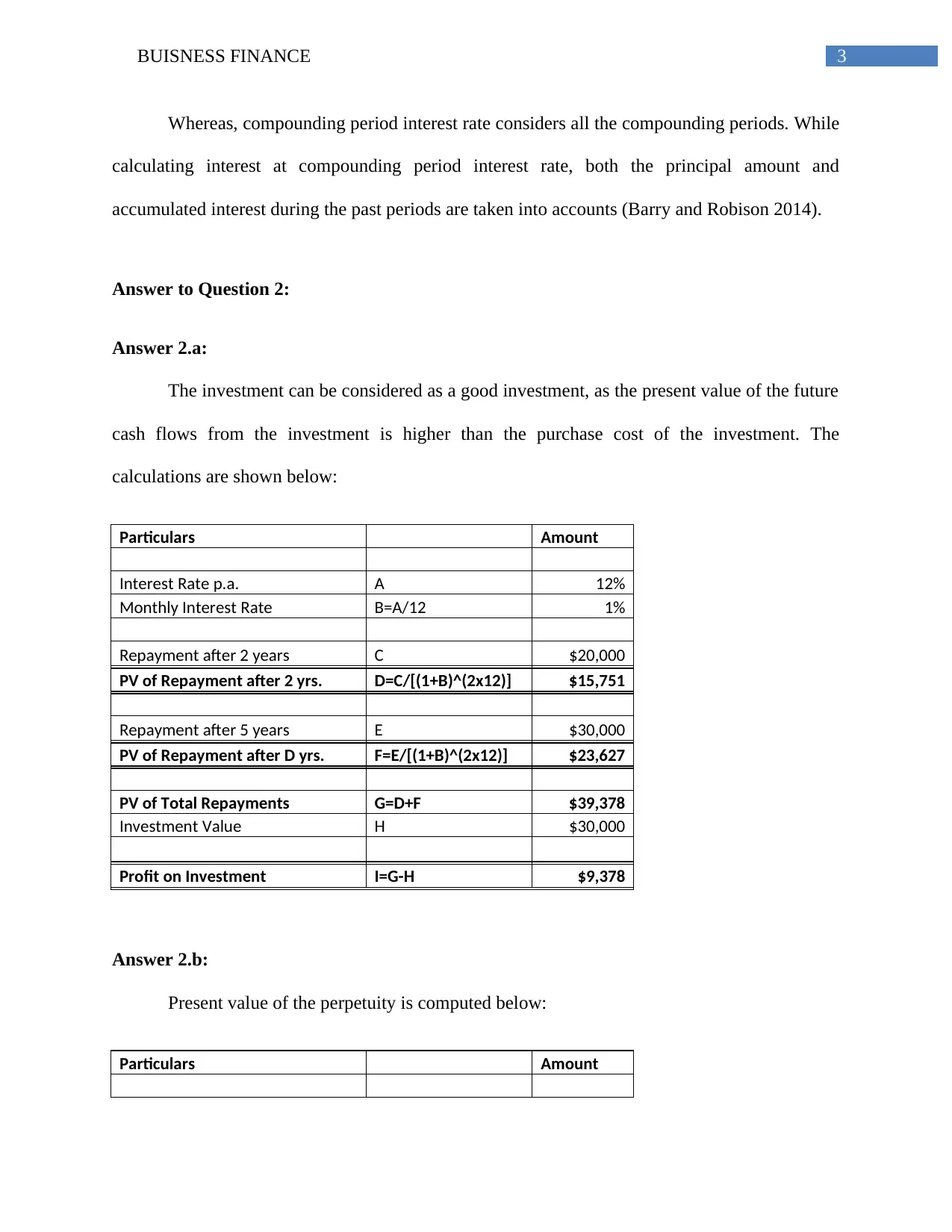
3BUISNESS FINANCE
Whereas, compounding period interest rate considers all the compounding periods. While
calculating interest at compounding period interest rate, both the principal amount and
accumulated interest during the past periods are taken into accounts (Barry and Robison 2014).
Answer to Question 2:
Answer 2.a:
The investment can be considered as a good investment, as the present value of the future
cash flows from the investment is higher than the purchase cost of the investment. The
calculations are shown below:
Particulars Amount
Interest Rate p.a. A 12%
Monthly Interest Rate B=A/12 1%
Repayment after 2 years C $20,000
PV of Repayment after 2 yrs. D=C/[(1+B)^(2x12)] $15,751
Repayment after 5 years E $30,000
PV of Repayment after D yrs. F=E/[(1+B)^(2x12)] $23,627
PV of Total Repayments G=D+F $39,378
Investment Value H $30,000
Profit on Investment I=G-H $9,378
Answer 2.b:
Present value of the perpetuity is computed below:
Particulars Amount
Whereas, compounding period interest rate considers all the compounding periods. While
calculating interest at compounding period interest rate, both the principal amount and
accumulated interest during the past periods are taken into accounts (Barry and Robison 2014).
Answer to Question 2:
Answer 2.a:
The investment can be considered as a good investment, as the present value of the future
cash flows from the investment is higher than the purchase cost of the investment. The
calculations are shown below:
Particulars Amount
Interest Rate p.a. A 12%
Monthly Interest Rate B=A/12 1%
Repayment after 2 years C $20,000
PV of Repayment after 2 yrs. D=C/[(1+B)^(2x12)] $15,751
Repayment after 5 years E $30,000
PV of Repayment after D yrs. F=E/[(1+B)^(2x12)] $23,627
PV of Total Repayments G=D+F $39,378
Investment Value H $30,000
Profit on Investment I=G-H $9,378
Answer 2.b:
Present value of the perpetuity is computed below:
Particulars Amount
Paraphrase This Document
Need a fresh take? Get an instant paraphrase of this document with our AI Paraphraser
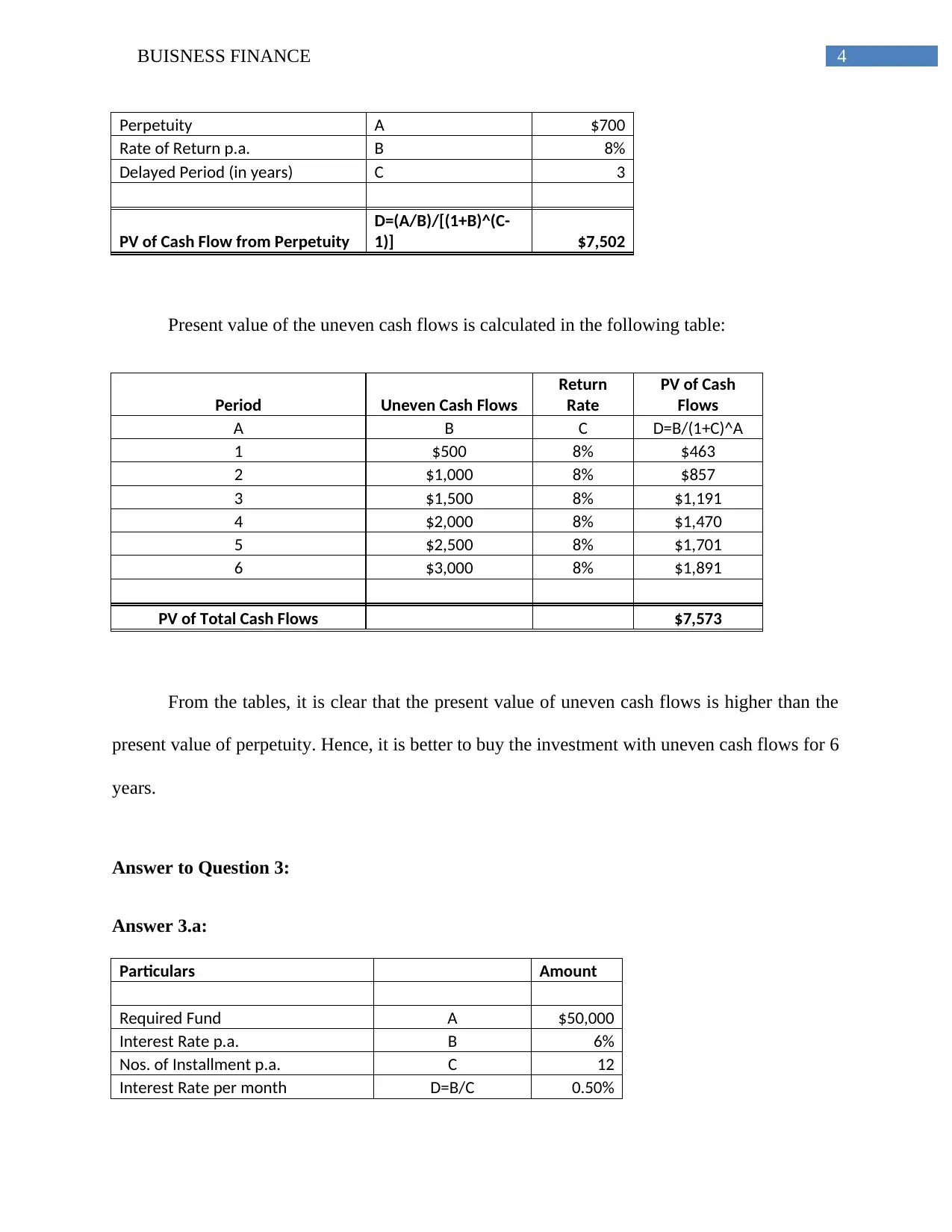
4BUISNESS FINANCE
Perpetuity A $700
Rate of Return p.a. B 8%
Delayed Period (in years) C 3
PV of Cash Flow from Perpetuity
D=(A/B)/[(1+B)^(C-
1)] $7,502
Present value of the uneven cash flows is calculated in the following table:
Period Uneven Cash Flows
Return
Rate
PV of Cash
Flows
A B C D=B/(1+C)^A
1 $500 8% $463
2 $1,000 8% $857
3 $1,500 8% $1,191
4 $2,000 8% $1,470
5 $2,500 8% $1,701
6 $3,000 8% $1,891
PV of Total Cash Flows $7,573
From the tables, it is clear that the present value of uneven cash flows is higher than the
present value of perpetuity. Hence, it is better to buy the investment with uneven cash flows for 6
years.
Answer to Question 3:
Answer 3.a:
Particulars Amount
Required Fund A $50,000
Interest Rate p.a. B 6%
Nos. of Installment p.a. C 12
Interest Rate per month D=B/C 0.50%
Perpetuity A $700
Rate of Return p.a. B 8%
Delayed Period (in years) C 3
PV of Cash Flow from Perpetuity
D=(A/B)/[(1+B)^(C-
1)] $7,502
Present value of the uneven cash flows is calculated in the following table:
Period Uneven Cash Flows
Return
Rate
PV of Cash
Flows
A B C D=B/(1+C)^A
1 $500 8% $463
2 $1,000 8% $857
3 $1,500 8% $1,191
4 $2,000 8% $1,470
5 $2,500 8% $1,701
6 $3,000 8% $1,891
PV of Total Cash Flows $7,573
From the tables, it is clear that the present value of uneven cash flows is higher than the
present value of perpetuity. Hence, it is better to buy the investment with uneven cash flows for 6
years.
Answer to Question 3:
Answer 3.a:
Particulars Amount
Required Fund A $50,000
Interest Rate p.a. B 6%
Nos. of Installment p.a. C 12
Interest Rate per month D=B/C 0.50%
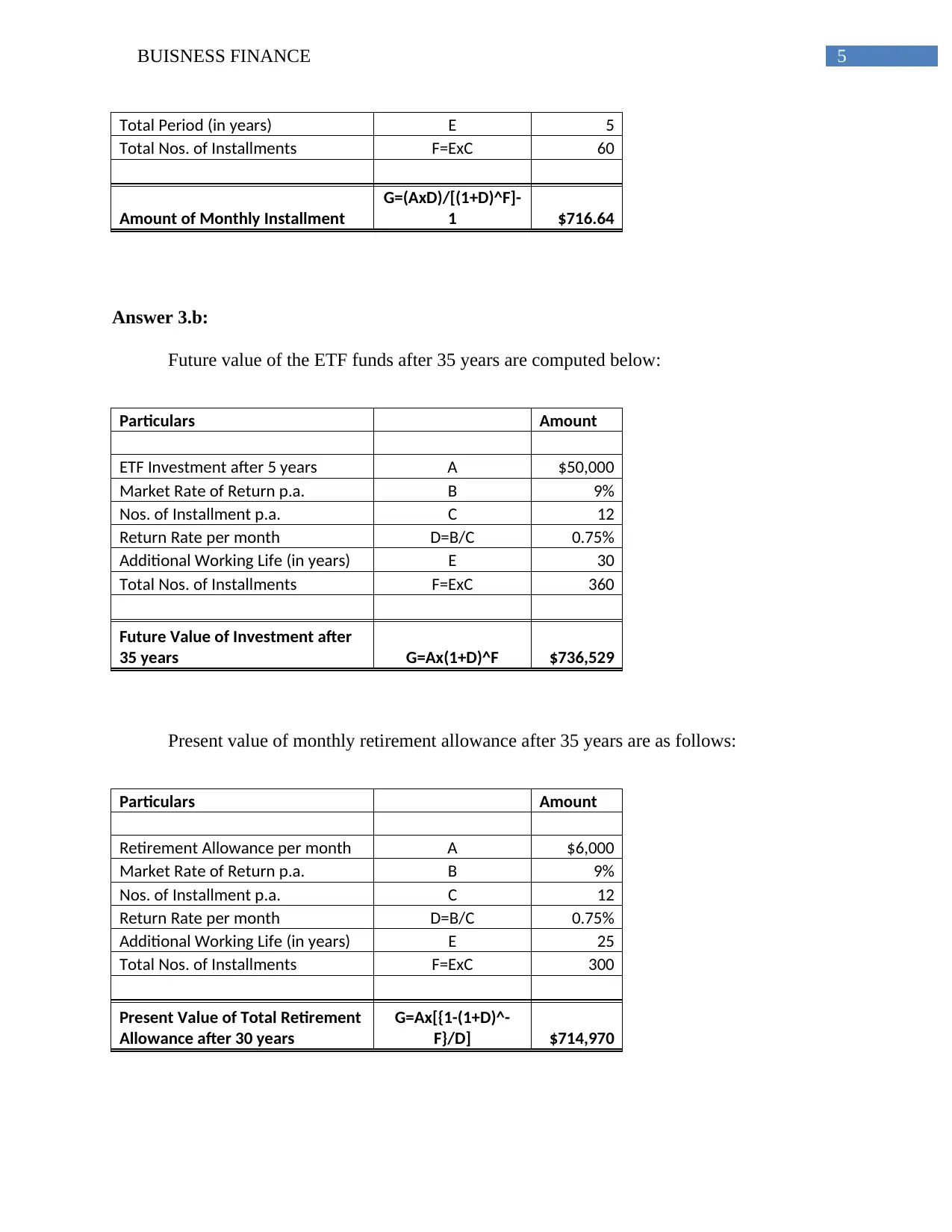
5BUISNESS FINANCE
Total Period (in years) E 5
Total Nos. of Installments F=ExC 60
Amount of Monthly Installment
G=(AxD)/[(1+D)^F]-
1 $716.64
Answer 3.b:
Future value of the ETF funds after 35 years are computed below:
Particulars Amount
ETF Investment after 5 years A $50,000
Market Rate of Return p.a. B 9%
Nos. of Installment p.a. C 12
Return Rate per month D=B/C 0.75%
Additional Working Life (in years) E 30
Total Nos. of Installments F=ExC 360
Future Value of Investment after
35 years G=Ax(1+D)^F $736,529
Present value of monthly retirement allowance after 35 years are as follows:
Particulars Amount
Retirement Allowance per month A $6,000
Market Rate of Return p.a. B 9%
Nos. of Installment p.a. C 12
Return Rate per month D=B/C 0.75%
Additional Working Life (in years) E 25
Total Nos. of Installments F=ExC 300
Present Value of Total Retirement
Allowance after 30 years
G=Ax[{1-(1+D)^-
F}/D] $714,970
Total Period (in years) E 5
Total Nos. of Installments F=ExC 60
Amount of Monthly Installment
G=(AxD)/[(1+D)^F]-
1 $716.64
Answer 3.b:
Future value of the ETF funds after 35 years are computed below:
Particulars Amount
ETF Investment after 5 years A $50,000
Market Rate of Return p.a. B 9%
Nos. of Installment p.a. C 12
Return Rate per month D=B/C 0.75%
Additional Working Life (in years) E 30
Total Nos. of Installments F=ExC 360
Future Value of Investment after
35 years G=Ax(1+D)^F $736,529
Present value of monthly retirement allowance after 35 years are as follows:
Particulars Amount
Retirement Allowance per month A $6,000
Market Rate of Return p.a. B 9%
Nos. of Installment p.a. C 12
Return Rate per month D=B/C 0.75%
Additional Working Life (in years) E 25
Total Nos. of Installments F=ExC 300
Present Value of Total Retirement
Allowance after 30 years
G=Ax[{1-(1+D)^-
F}/D] $714,970
⊘ This is a preview!⊘
Do you want full access?
Subscribe today to unlock all pages.

Trusted by 1+ million students worldwide
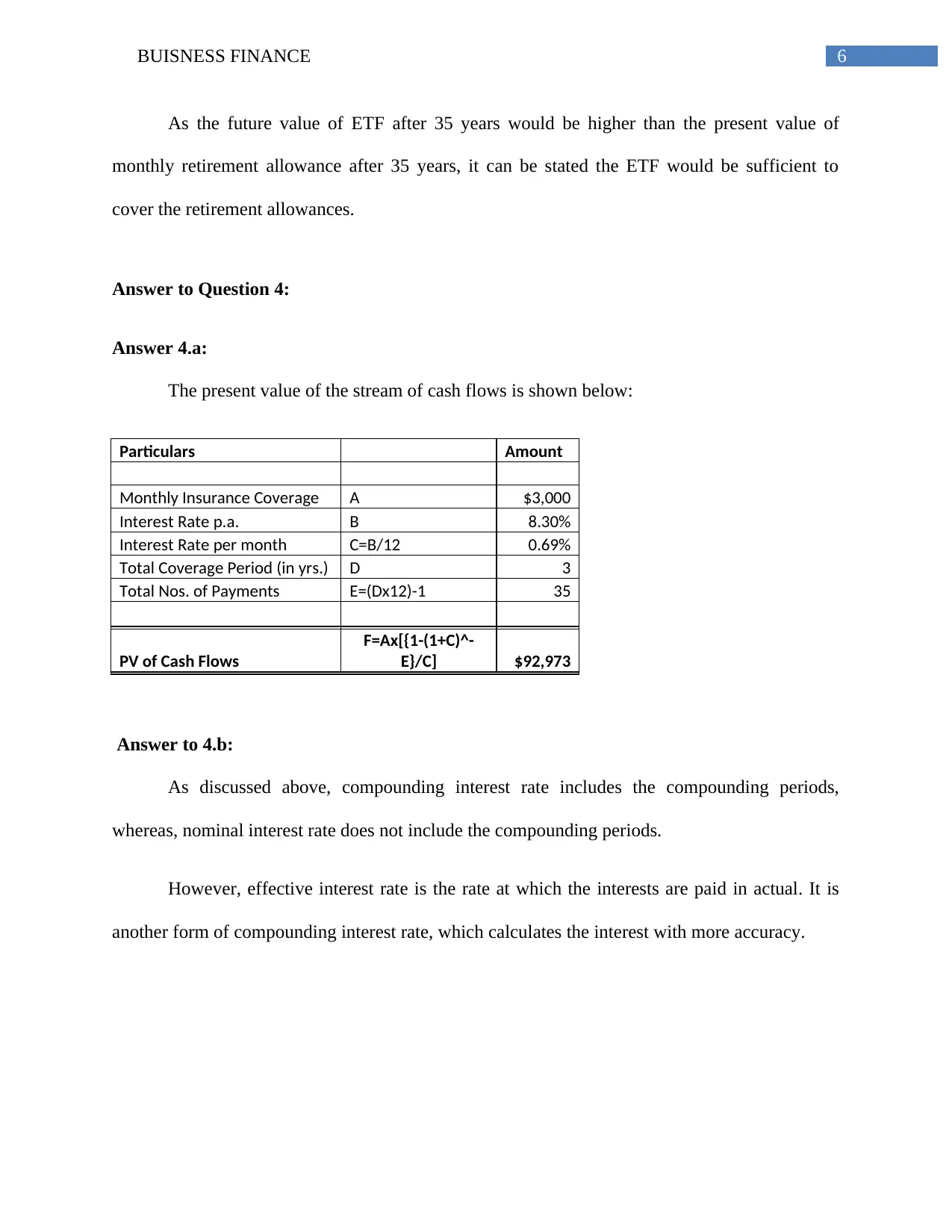
6BUISNESS FINANCE
As the future value of ETF after 35 years would be higher than the present value of
monthly retirement allowance after 35 years, it can be stated the ETF would be sufficient to
cover the retirement allowances.
Answer to Question 4:
Answer 4.a:
The present value of the stream of cash flows is shown below:
Particulars Amount
Monthly Insurance Coverage A $3,000
Interest Rate p.a. B 8.30%
Interest Rate per month C=B/12 0.69%
Total Coverage Period (in yrs.) D 3
Total Nos. of Payments E=(Dx12)-1 35
PV of Cash Flows
F=Ax[{1-(1+C)^-
E}/C] $92,973
Answer to 4.b:
As discussed above, compounding interest rate includes the compounding periods,
whereas, nominal interest rate does not include the compounding periods.
However, effective interest rate is the rate at which the interests are paid in actual. It is
another form of compounding interest rate, which calculates the interest with more accuracy.
As the future value of ETF after 35 years would be higher than the present value of
monthly retirement allowance after 35 years, it can be stated the ETF would be sufficient to
cover the retirement allowances.
Answer to Question 4:
Answer 4.a:
The present value of the stream of cash flows is shown below:
Particulars Amount
Monthly Insurance Coverage A $3,000
Interest Rate p.a. B 8.30%
Interest Rate per month C=B/12 0.69%
Total Coverage Period (in yrs.) D 3
Total Nos. of Payments E=(Dx12)-1 35
PV of Cash Flows
F=Ax[{1-(1+C)^-
E}/C] $92,973
Answer to 4.b:
As discussed above, compounding interest rate includes the compounding periods,
whereas, nominal interest rate does not include the compounding periods.
However, effective interest rate is the rate at which the interests are paid in actual. It is
another form of compounding interest rate, which calculates the interest with more accuracy.
Paraphrase This Document
Need a fresh take? Get an instant paraphrase of this document with our AI Paraphraser
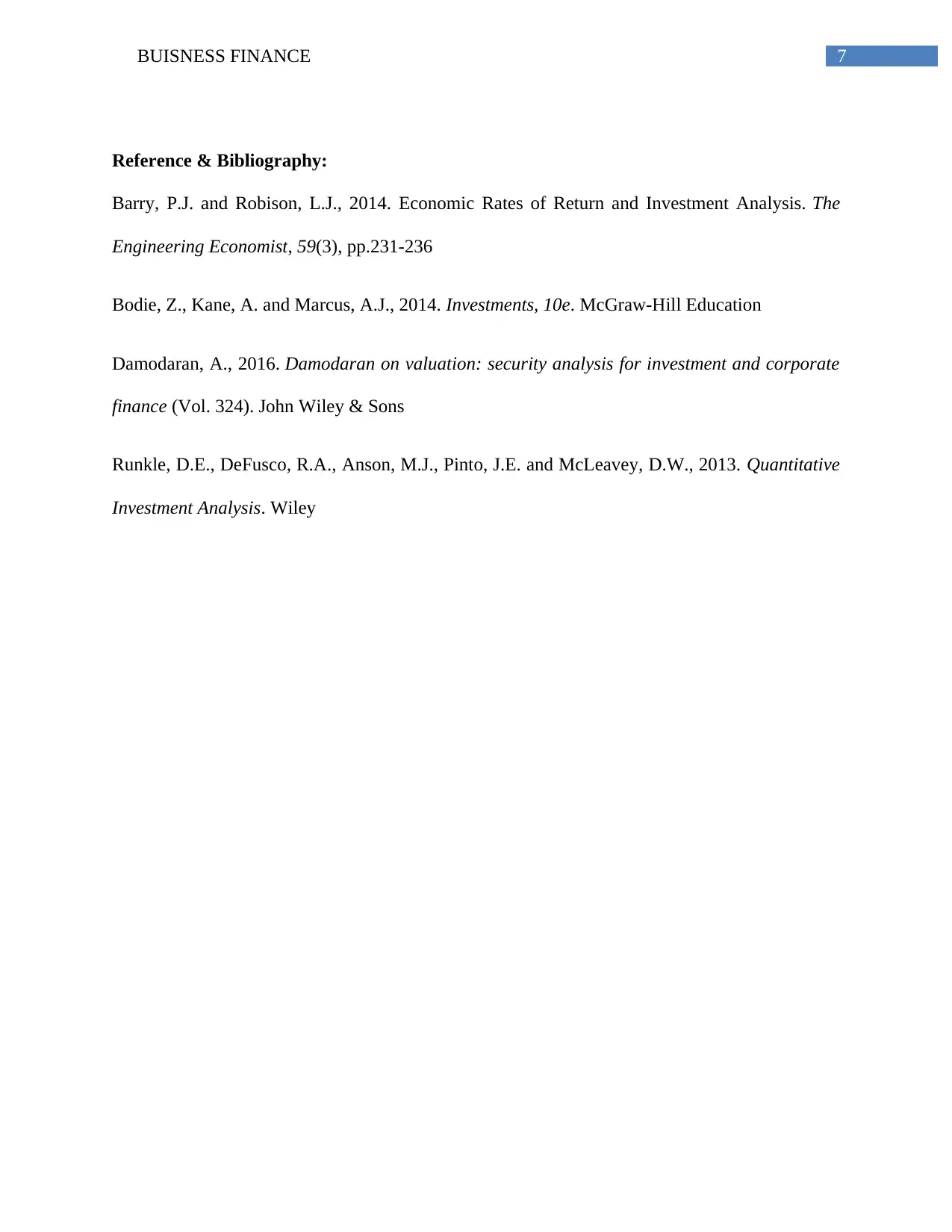
7BUISNESS FINANCE
Reference & Bibliography:
Barry, P.J. and Robison, L.J., 2014. Economic Rates of Return and Investment Analysis. The
Engineering Economist, 59(3), pp.231-236
Bodie, Z., Kane, A. and Marcus, A.J., 2014. Investments, 10e. McGraw-Hill Education
Damodaran, A., 2016. Damodaran on valuation: security analysis for investment and corporate
finance (Vol. 324). John Wiley & Sons
Runkle, D.E., DeFusco, R.A., Anson, M.J., Pinto, J.E. and McLeavey, D.W., 2013. Quantitative
Investment Analysis. Wiley
Reference & Bibliography:
Barry, P.J. and Robison, L.J., 2014. Economic Rates of Return and Investment Analysis. The
Engineering Economist, 59(3), pp.231-236
Bodie, Z., Kane, A. and Marcus, A.J., 2014. Investments, 10e. McGraw-Hill Education
Damodaran, A., 2016. Damodaran on valuation: security analysis for investment and corporate
finance (Vol. 324). John Wiley & Sons
Runkle, D.E., DeFusco, R.A., Anson, M.J., Pinto, J.E. and McLeavey, D.W., 2013. Quantitative
Investment Analysis. Wiley
1 out of 8
Related Documents
Your All-in-One AI-Powered Toolkit for Academic Success.
+13062052269
info@desklib.com
Available 24*7 on WhatsApp / Email
![[object Object]](/_next/static/media/star-bottom.7253800d.svg)
Unlock your academic potential
Copyright © 2020–2025 A2Z Services. All Rights Reserved. Developed and managed by ZUCOL.





